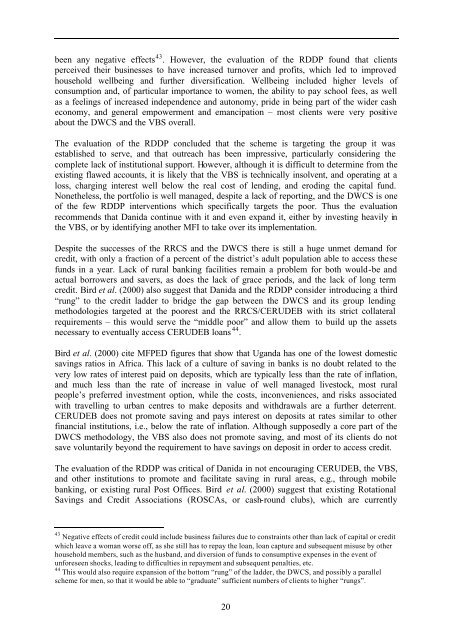Access to Rural Non-Farm Livelihoods - Natural Resources Institute
Access to Rural Non-Farm Livelihoods - Natural Resources Institute
Access to Rural Non-Farm Livelihoods - Natural Resources Institute
Create successful ePaper yourself
Turn your PDF publications into a flip-book with our unique Google optimized e-Paper software.
een any negative effects 43 . However, the evaluation of the RDDP found that clients<br />
perceived their businesses <strong>to</strong> have increased turnover and profits, which led <strong>to</strong> improved<br />
household wellbeing and further diversification. Wellbeing included higher levels of<br />
consumption and, of particular importance <strong>to</strong> women, the ability <strong>to</strong> pay school fees, as well<br />
as a feelings of increased independence and au<strong>to</strong>nomy, pride in being part of the wider cash<br />
economy, and general empowerment and emancipation – most clients were very positive<br />
about the DWCS and the VBS overall.<br />
The evaluation of the RDDP concluded that the scheme is targeting the group it was<br />
established <strong>to</strong> serve, and that outreach has been impressive, particularly considering the<br />
complete lack of institutional support. However, although it is difficult <strong>to</strong> determine from the<br />
existing flawed accounts, it is likely that the VBS is technically insolvent, and operating at a<br />
loss, charging interest well below the real cost of lending, and eroding the capital fund.<br />
<strong>Non</strong>etheless, the portfolio is well managed, despite a lack of reporting, and the DWCS is one<br />
of the few RDDP interventions which specifically targets the poor. Thus the evaluation<br />
recommends that Danida continue with it and even expand it, either by investing heavily in<br />
the VBS, or by identifying another MFI <strong>to</strong> take over its implementation.<br />
Despite the successes of the RRCS and the DWCS there is still a huge unmet demand for<br />
credit, with only a fraction of a percent of the district’s adult population able <strong>to</strong> access these<br />
funds in a year. Lack of rural banking facilities remain a problem for both would-be and<br />
actual borrowers and savers, as does the lack of grace periods, and the lack of long term<br />
credit. Bird et al. (2000) also suggest that Danida and the RDDP consider introducing a third<br />
“rung” <strong>to</strong> the credit ladder <strong>to</strong> bridge the gap between the DWCS and its group lending<br />
methodologies targeted at the poorest and the RRCS/CERUDEB with its strict collateral<br />
requirements – this would serve the “middle poor” and allow them <strong>to</strong> build up the assets<br />
necessary <strong>to</strong> eventually access CERUDEB loans 44 .<br />
Bird et al. (2000) cite MFPED figures that show that Uganda has one of the lowest domestic<br />
savings ratios in Africa. This lack of a culture of saving in banks is no doubt related <strong>to</strong> the<br />
very low rates of interest paid on deposits, which are typically less than the rate of inflation,<br />
and much less than the rate of increase in value of well managed lives<strong>to</strong>ck, most rural<br />
people’s preferred investment option, while the costs, inconveniences, and risks associated<br />
with travelling <strong>to</strong> urban centres <strong>to</strong> make deposits and withdrawals are a further deterrent.<br />
CERUDEB does not promote saving and pays interest on deposits at rates similar <strong>to</strong> other<br />
financial institutions, i.e., below the rate of inflation. Although supposedly a core part of the<br />
DWCS methodology, the VBS also does not promote saving, and most of its clients do not<br />
save voluntarily beyond the requirement <strong>to</strong> have savings on deposit in order <strong>to</strong> access credit.<br />
The evaluation of the RDDP was critical of Danida in not encouraging CERUDEB, the VBS,<br />
and other institutions <strong>to</strong> promote and facilitate saving in rural areas, e.g., through mobile<br />
banking, or existing rural Post Offices. Bird et al. (2000) suggest that existing Rotational<br />
Savings and Credit Associations (ROSCAs, or cash-round clubs), which are currently<br />
43 Negative effects of credit could include business failures due <strong>to</strong> constraints other than lack of capital or credit<br />
which leave a woman worse off, as she still has <strong>to</strong> repay the loan, loan capture and subsequent misuse by other<br />
household members, such as the husband, and diversion of funds <strong>to</strong> consumptive expenses in the event of<br />
unforeseen shocks, leading <strong>to</strong> difficulties in repayment and subsequent penalties, etc.<br />
44 This would also require expansion of the bot<strong>to</strong>m “rung” of the ladder, the DWCS, and possibly a parallel<br />
scheme for men, so that it would be able <strong>to</strong> “graduate” sufficient numbers of clients <strong>to</strong> higher “rungs”.<br />
20

















